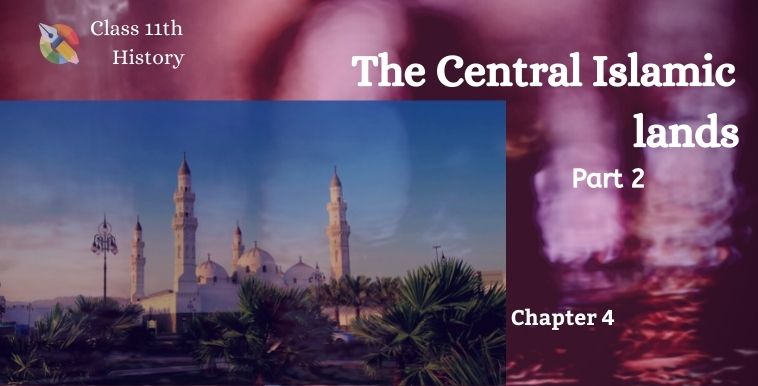This post is the precise notes second part of class 11 NCERT chapter 4 history notes (The Central Islamic Lands).
The Crusades
- Christians had their own scripture that’s why they were regarded as the people of the book.
- In 638, Jerusalem was conquered by Arabs, but still it was a holy place for Christians as the place of Jesus’ crucifixion and resurrection.
- In the 11th century, Normans, Hungarians and Slavs had been converted to Christianity.
- The clergy and the warrior class were making efforts to create political and economic stability by the peace of God movement.
- All military violence was forbidden in certain areas, like near places of worship, during the sacred periods of the Church’s calendar.
- Baghdad was disintegrated after the death of Malik Shah (Saljuq Sultan) in 1092.
- Alexius I (the Byzantine emperor) recaptured Asia Minor and northern Syria In 1095, Pope Urban II, joined Alexius I for a war in the name of God to regain the Holy land.
- Between 1095 and 1291, western European Christians fought wars against Muslim cities eastern Mediterranean. These wars were known as crusades.
The First Crusade (1098-99)
- French and Italian soldiers captured Antioch in Syria and claimed Jerusalem. Muslim writers referred this war as a Frankish invasion.
- The Franks established four crusader states in the Syria- Palestine region known as Outremer.
The Second Crusade (1145-49)
- The Turks captured Edessa in 1144. The Pope appealed for a second crusade. A combined German and French army made an attempt to capture Damascus but they failed and their power declined gradually.
- Salah-al-din created an Egypto-Syrian empire. He called a crusade against the Christians and defeated them in 1187. He regained Jerusalem and turned a number of churches into mosques. Jerusalem once again became a Muslim City.
The Third Crusade (1189)
- In the third crusade, the crusaders gained only free access to Jerusalem for Christian pilgrims.
- The Mamluks, (the ruler of Egypt) finally drove the Christians crusaders from Palestine in 1291.
Economy: Agriculture, Urbanization and Commerce
Agriculture
It was the main occupation and its income came from land revenue. There were two types of taxes.
Kharaj
Half to a fifth of the produce levied in the form of tax by non- Muslims.
Ushr
» Tax levied was one-tenth of the produced by Muslims cultivators.
» When non-Muslims started to convert to Islam to pay lower taxes, this reduce the income of the state.
» To discourage conversion, the caliphs adopted a uniform policy of taxation. Islamic law gave tax concessions to people, who brought land under cultivation. Many new crops were grown and exported to Europe.
Urbanisation
» Many cities were founded to settle Arab soldiers like Kufa and Basra in Iraq, Fustat and Cairo in Egypt.
» Two things were important in the cities: the congregational (big) mosque and the central marketplace (Suq).
Illustration of the Islamic Cities

Commerce
- Political unification and urban demand for foodstuff and luxuries enlarged the circuit of exchange.
- Arab traders traded such as spices, textile porcelain etc. with China, India and Europe by the two major routes, The Red sea and the Persian gulf.
- Slaves trade were also prevailed in this markets.
- The fiscal system (finance) and market exchange increased the importance of money in the central Islamic lands.
- Coins of gold (from Africa: Sudan) silver (from Central Asia) copper and precious metals (from Europe) were minted and circulated.
- Letters of credit and bills of exchange were used by merchants and bankers to transfer money.
- Interest-bearing transactions (Riba) were unlawful.
Learning and culture
- Through the contact of with other people, Muslims were obliged to reflect on itself and confront issues pertaining to God and the world.
- Many questions raised in the community. what should be the ideal conduct of a Muslim in public and in private? What does God want from his creatures?
- Religious scholars try to satisfy the intellectual curiosity of the medium of Quran and Hadith.
- For religious scholars, knowledge derived from the Quran and the model behaviour of the profit was the only way to know the will of God.
- Some went on to prepare a body of law or Sharia.
- In framing Islamic law, jurists also made use of reasoning (qiyas) since not every thing was apparent in the Quran and Hadith.
- In the 8th and 9th centuries, there were four schools of law (Mazhab): Maliki, Hanafi, Shafii, and Hanbali.
- Hanbali was the most conservative School.
- The Sharia provided guidance on all possible personal legal issues like marriage, divorce and inheritance within Sunni society.
Sufis
- A new group emerged in mediaeval Islam known as Sufis, sought a deeper and more personal knowledge of God through asceticism and mysticism.
- In the 8th and 9th centuries, ascetic inclinations were elevated to the higher stage of mysticism by the ideas of pantheism and love.
- Pantheism is the idea of oneness of God and the human soul.
- Bayazid Bistami an Iranian Sufi, was the first to teach the importance of submerging the self in God.
- Sufism gained popularity and posed a challenge to orthodox Islam.
- An alternative vision of God and the universe was developed by Islamic philosophers and scientists under the influence of Greek philosophy and science.
- Indian works on astronomy, mathematics and medicine were also translated into Arabic.
- The study of new subjects promoted critical inquiry and had a profound influence on Islamic intellectual life.
- Ibn Sina( 980-1037) a doctor and philosopher, did not believe in the resurrection. This was met with strong opposition from theologians.
- Fine language and a creative imagination were the most appreciated qualities in a person’s communication called ‘Adab’, which means literary and cultural refinement.
- The ancient Iranian language, Pahlavi (the language of sacred books) was in decay.
- A version of pahlavi known as new Persian.
- Rudaki (the Samanid court poet) was considered the father of new Persian poetry, including ghazal and rubai.
- The rubai reached its zenith in the hands of Umar Khayyam.
- In the 11th century, Ghazni became the center of Persian literary life.
- Rulers patronised the court poets.
- Firdausi was the outstanding poet who wrote Shahnama, which poetically depicts Iran from creation up until the Arab conquest.
Stories
- Baghdad bookseller, Ibn Nadim, describes a large number of works written in prose for the moral education and amusement of readers.
- The oldest collection of animal fables called kalila wa dimna, the story of two jackals, which is the Arabic translation of the pahlavi version of the Panchatantra. The most adventurous stories include Alexander, sindbad, unhappy lovers like Majnu.
- ‘The thousand and one nights’ is another collection of stories of different- different types of characters.
History
History books were read by scholars and students as history provided a good record of the glories and achievements of the dynasty, and set examples of the techniques of administration for rulers and officials.
Geography and Travel (Rihla)
- These combined knowledge came from Greek, Iranian and Indian books with the observations of merchants and travellers.
- In mathematical geography, the inhabited world was divided into seven climes.
- Tahqiq ma lil- Hind (History of India) was the greatest attempt of Alberuni.
Basic Forms of Designs
- Arches, domes, minarets and open courtyard were the basic features of the religious buildings like mosques, shrines and tombs from Spain to Central Asia.
- The same pattern of construction appeared in caravanserais, hospitals and palaces.
Art
- Religious art of Islam promoted two art forms; calligraphy (beautiful writing) and arabesque ( geometry shapes).
- Small and big inscriptions were used to decorate the architecture. plant and floral designs were used in buildings and book illustrations.
Important Aspects of Human Civilization
- The central Islamic lands are brought together by three aspects; religion, community and politics.
- In the 7th century, these three circles were merged and appeared as one but in the next five centuries these circles separated.
- The influence of Islam over state and government was minimal.
Share this note with your friends and classmates and also comment in the comment section below.
Click here to read the first part of The Central Islamic Lands.











wow notes
great
thanks for the notes
super notes ma’am
its fantasticit’s fav
Superb